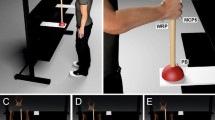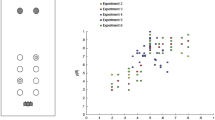Abstract
Previous studies showed that initial comfort of a posture is traded for a better control at the end position, a phenomenon which has been termed the end-state comfort effect. When participants recall a recently performed motor plan, the end-state comfort effect is reduced. Two experiments investigated whether observing the grasp of another person is sufficient for later recall. Participants moved an object from a home location to different target positions. Results replicated an end-state comfort effect, revealing an inverse relation of grasp height to target height for the first movement. When participants later returned the object back to the home position, recall of the previously self-performed action dominated, replicating the reduction in end-state comfort due to recall processes. Notably, the end-state comfort effect was also reduced in conditions in which a model performed the first movement and in which the participant performed only the second movement (Experiment 1). Model actions were also recalled in situations in which the observed action was incongruent with a comfortable end position of the participant (Experiment 2). These results suggest that observed actions of others can serve as templates for movement planning in social situations.




Similar content being viewed by others
References
Alaerts K, Swinnen SP, Wenderoth N (2010) Observing how others lift light or heavy objects: which visual cues mediate the encoding of muscular force in the primary motor cortex? Neuropsychologia 48:2082–2090
Bandura A (1986) Social foundations of thought and action: a social cognitive theory. Prentice-Hall, Inc., Englewood Cliffs, NJ
Becchio C, Sartori L, Bulgheroni M, Castiello U (2008) The case of Dr. Jekyll and Mr. Hyde: a kinematic study on social intention. Conscious Cogn 17:557–564
Brass M, Bekkering H, Prinz W (2001) Movement observation affects movement execution in a simple response task. Acta Psychol 106:3–22
Calvo-Merino B, Glaser DE, Grèzes J, Passingham RE, Haggard P (2005) Action observation and acquired motor skills: an FMRI study with expert dancers. Cereb Cortex 15:1243–1249
Castiello U, Lusher D, Mari M, Edwards M, Humphreys GW (2002) Observing a human or a robotic hand grasping an object: differential motor priming effects. Common Mech Percept Action Atten Perform XIX:315–333
Charpentier A (1891) Analyse experimentale de quelgues elements de la sensation de poids. Arch Physiol Norm Pathol 3:122–135
Cohen RG, Rosenbaum DA (2004) Where grasps are made reveals how grasps are planned: generation and recall of motor plans. Exp Brain Res 157:486–495
Edwards MG, Humphreys GW, Castiello U (2003) Motor facilitation following action observation: a behavioural study in prehensile action. Brain Cogn 53:495–502
Gallese V, Goldman A (1998) Mirror neurons and the simulation theory of mind-reading. Trends Cogn Sci 2:493–501
Jeannerod M (2006) Motor cognition: what action tells the self. Oxford University Press, Oxford
Kilner J, Paulignan Y, Blakemore S (2003) An interference effect of observed biological movement on action. Curr Biol 13:522–525
Loftus GR, Masson ME (1994) Using confidence intervals in within-subject designs. Psychon Bull Rev 1:476–490
Meulenbroek RG, Bosga J, Hulstijn M, Miedl S (2007) Joint-action coordination in transferring objects. Exp Brain Res 180:333–343
Meyer M, van der Wel R, Hunnius S (2013) Higher-order action planning for individual and joint object manipulations. Exp Brain Res 225:579–588
Oldfield RC (1971) The assessment and analysis of handedness: the Edinburgh inventory. Neuropsychologia 9:97–113
Pfister R, Janczyk M (2013) Confidence intervals for two sample means: calculation, interpretation, and a few simple rules. Adv Cogn Psychol 9:74–80
Rosenbaum DA, Marchak F, Barnes HJ, Vaughan J, Slotta JD, Jorgensen MJ (1990) Constraints for action selection: overhand versus underhand grips. In: Jeannerod M (ed) Attention and performance XIII: motor representation and control. Lawrence Erlbaum Associates, Hillsdale, NJ, pp 321–342
Rosenbaum DA, Meulenbroek RJ, Vaughan J, Jansen C (2001) Posture-based motion planning: applications to grasping. Psychol Rev 108:709
Rosenbaum DA, Chapman KM, Weigelt M, Weiss DJ, van der Wel R (2012) Cognition, action, and object manipulation. Psychol Bull 138:924–946
Sebanz N, Knoblich G (2009) Prediction in joint action: what, when, and where. Top Cogn Sci 1:353–367
Sebanz N, Bekkering H, Knoblich G (2006) Joint action: bodies and minds moving together. Trends Cogn Sci 10:70–76
van der Wel RP, Rosenbaum DA (2010) Bimanual grasp planning reflects changing rather than fixed constraint dominance. Exp Brain Res 205:351–362
Weigelt M, Cohen R, Rosenbaum DA (2007) Returning home: location memory versus posture memory in object manipulation. Exp Brain Res 179:191–198
Wilson M, Knoblich G (2005) The case for motor involvement in perceiving conspecifics. Psychol Bull 131:460
Acknowledgments
This research was supported by a Grant of the German Research Foundation (DFG) to Andreas Eder (ED 201/2-1). We thank Oliver Herbort for helpful discussions of this research, David Rosenbaum and Robrecht van der Wel for helpful comments on an earlier draft of this article, and Svenja Gerlich and Felix Debuschewitz for their help conducting the experiments.
Author information
Authors and Affiliations
Corresponding author
Rights and permissions
About this article
Cite this article
Dignath, D., Eder, A.B. Recall of observed actions modulates the end-state comfort effect just like recall of one’s own actions. Exp Brain Res 231, 75–83 (2013). https://doi.org/10.1007/s00221-013-3668-0
Received:
Accepted:
Published:
Issue Date:
DOI: https://doi.org/10.1007/s00221-013-3668-0




